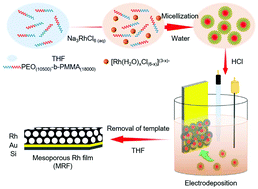Electrochemical supermolecular templating of mesoporous Rh films†
Abstract
Making mesoporous rhodium (Rh) with traditional soft-templating methods is challenging because Rh has a high surface energy compared to other metals. Here, we report a synthetic concept to generate mesoporous Rh films (MRFs) by electrochemical co-deposition of Rh precursors and block copolymer micelles. We investigate the effect of deposition potentials and pH on the resulting mesoporous structures. Controlled electrodeposition enables us to conformally coat the entire surface of the electrode with a homogeneous mesoporous Rh film with any arbitrary thickness up to ∼840 nm. The average pore size of the MRF is ∼14 nm, with an average wall thickness of ∼9.5 nm. Since the MRFs are directly deposited on conducting substrates, they can be used as porous electrodes for various important electrocatalytic reactions. We examine the performance of these MRFs for the electrochemical methanol oxidation reaction (MOR) and find that they have a mass-normalized peak current density ∼4 times higher than a commercial Rh black (RhB) catalyst.



 Please wait while we load your content...
Please wait while we load your content...